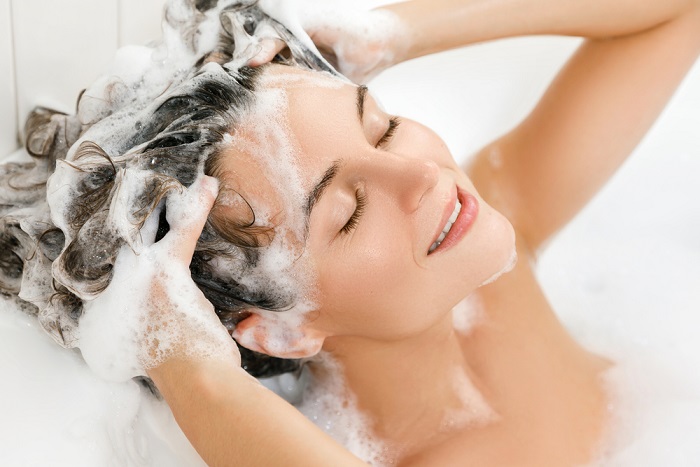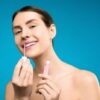
When was the last time you cared for your scalp and gave it the same amount of love and attention as you give those lovely tresses of yours?
It’s probably been a bit.
From growing your hair to protecting your brain from infection, the scalp is an often-overlooked but hardworking and indispensable part of your anatomy. Due to its unique physiology, caring for and pampering your scalp via exfoliation,whether that be a scalp brush or chemical exfoliants, should be part of your self-care practice.
That’s why we’ve put together this guide to help you understand how to properly exfoliate your scalp and why scalp scrubbing matters in hair care.
Scalp Exfoliation 101
Generally speaking, exfoliation is the process of physically or chemically removing buildup from the skin. Exfoliants are available for your face, body, and scalp.
When it comes to your scalp, in particular, there are a number of different products you can use for exfoliation. However, every exfoliant is identified as either a chemical exfoliant or a physical exfoliant:
- Chemical Scalp Exfoliant – Also referred to as a scalp mask or scalp treatment, these products rely on the chemical action of an acid—commonly salicylic or glycolic—to remove residues from your scalp. Akin to a peel for your face, chemical scalp exfoliants dissolve and slough away oil and dead skin cells.
- Physical Scalp Exfoliants – Also called a scalp scrub, a physical scalp exfoliant relies on your own hand power to break up and remove any oil or dead skin cells that have accumulated on your scalp. These exfoliants typically contain microbeads or natural scrubbing materials like sugar, salt, or apricot seed, to assist with exfoliation.
Physical exfoliation can also be achieved with a special scalp massage brush that you can use on your scalp in the shower.
Nonetheless, whether it may be chemical or physical exfoliants, the process is important for ridding of the scalp buildup from hair products, treating a flaky scalp, or even promoting healthy hair growth.
How to Exfoliate Scalp: Step-by-Step
So regular scalp exfoliation is important for a healthy scalp, but how do you properly do it? Whether you choose a chemical or physical exfoliant for your scalp, you can follow these steps for the order to apply hair care products to ensure proper exfoliation:
- Shampoo
- Rinse
- Exfoliate
- Rinse
- Condition
- Rinse
When applying your exfoliant, gently massage it into your scalp in a circular motion to work the product through your hair and into your scalp.
When to Exfoliate Scalp
How often you need to exfoliate your scalp depends on your hair type and oiliness. However, experts recommend starting with one exfoliation session a week to see how your scalp reacts to this new treatment.1
Eventually, you may up your exfoliation to twice weekly or even daily, as needed.
When Not to Exfoliate Scalp
While scalp exfoliation can generally be beneficial to your scalp and hair health, there are instances when exfoliating may do more harm than good. To that end, it’s best to avoid exfoliating your scalp if you have any of the following conditions:
- An open cut or sore
- Scalp irritation or infection
- Sunburn
- Lice
- Sensitive scalp or skin
Why Does Scalp Exfoliation Matter?
Just like there are hair mask benefits that keep your locks protected and healthy, exfoliating your scalp has its benefits as well. Your scalp is the soft tissue layer that covers the bones of your head. The skin of your scalp is made of multiple layers and structures. Like the skin on the rest of your body, your scalp is composed of:
- The epidermis
- The dermis
Within the dermis of the scalp, we find two important (for our considerations today) structures:
- Hair follicles – Which make hair
- Sebaceous glands – Which make oil
The high density of these hair and oil structures makes the scalp unique from other body skin. In fact, it is the density of these structures that can lead to problems.
Although sebaceous oil is vital to the health of your scalp and can prevent dry scalp, when excess oil accumulates and mixes with naturally sloughing dead skin cells and residue from your hair care products, you can confront a slew of scalp and hair woes, like:
- Dandruff
- Dull or lank hair
- Excessive shedding
- Irritation
- Slow hair growth
Scalp buildup from excess oil, dead skin, and products can clog the hair follicle, which can cause hair loss. And this is why scalp exfoliation matters. By routinely cleaning away oil, dead skin cells, and product buildup through scalp exfoliation, you may be able to invigorate your scalp and promote the growth of strong, shiny, and healthy hair.
The next time you’re planning out your hair care routine, be sure to consider a scalp exfoliator to unlock your scalp’s potential healthy hair growth.
Find Your Best Self from Scalp to Toe with FabFitFun
At FabFitFun, we want to help you uncover your best self from the top of your head to the soles of your feet. That’s why our curated seasonal boxes contain amazing beauty, fashion, wellness, and home decor products from high-quality brands you know and love.
Take, for example, the OUAI Scalp & Body Scrub, available in our Summer ‘22 Box. This effective physical exfoliant contains a blend of sugar and coconut oils to cut through dirt, oil, and residue and leave your scalp (and body) feeling cleansed, soothed, and loved.
Join our annual or seasonal membership to access the OUAI scalp exfoliant, along with other exciting self-care products. No matter which plan you choose, you can easily customize each of your boxes to receive exactly what you’re looking for.
Sign up today to see why millions of people just like you are choosing FabFitFun.
Sources:
- International Journal of Trichology. Scalp Condition Impacts Hair Growth and Retention via Oxidative Stress. https://www.ncbi.nlm.nih.gov/pmc/articles/PMC6369642/
- StatPearls. Anatomy, Head and Neck, Scalp. https://www.ncbi.nlm.nih.gov/books/NBK551565/




